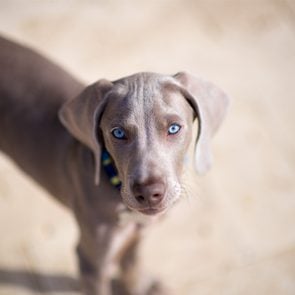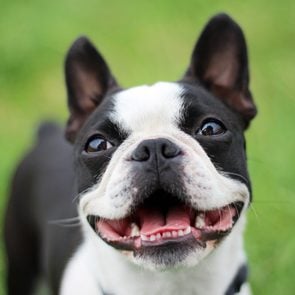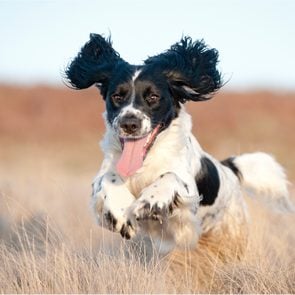9 Hairless Dog Breeds That Are Bald and Beautiful
Updated: Apr. 04, 2024
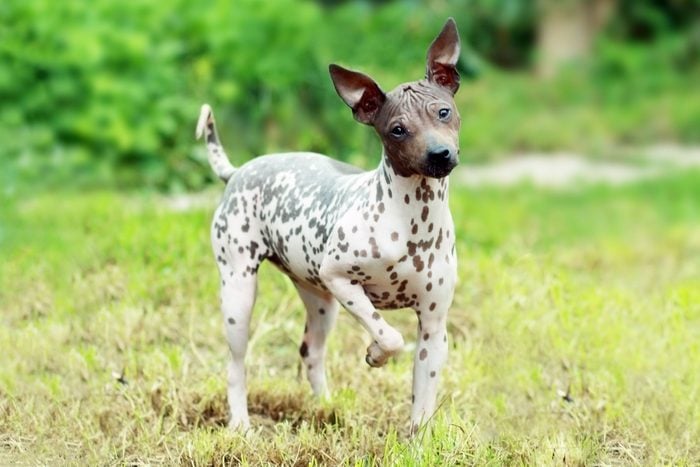
Hairless dogs might look weird, but people have loved them—and even worshipped them—since ancient times
Hairless dogs may look like sleek, avant-garde canines, but in truth, they’ve been around since ancient times, dating back to 13th-century China and 16th-century South America. Today, the most popular breed of hairless dog is the Chinese crested, but the xoloitzcuintli and American hairless terrier (AHT) are fast gaining fans. And who could forget the Peruvian Inca Orchid?
People like hairless dogs because they find them beautiful and figure they don’t shed much or need much brushing. There’s also a perception that, because they’re hairless, these dogs may work for people with allergies. But is that accurate? To find out the truth, we spoke with two veterinarians who own hairless dogs, as well as an experienced breeder. Read on to learn more about hairless dog breeds.
About the experts
|
Why are some dogs hairless?
Two different genes cause hairlessness in dogs. The first (FOXI3) is responsible for hairlessness in all but one of the four hairless breeds recognized by the American Kennel Club (AKC). This gene leaves stylish tufts of hair on the top of the head, the tail and the ankles. Here’s the weird thing (because hairless dogs aren’t weird enough): It also affects the teeth. These hairless dogs usually have a bunch of abnormal and missing teeth—it’s normal for them to be snaggle-toothed.
There’s something else odd about this hairless gene: It’s inherited as a semilethal dominant gene. Don’t worry—that’s not as bad as it sounds. It just means only one copy of the hairless gene is needed to cause hairlessness; if there are two copies, the embryo dies before developing. That’s why every hairless dog of these breeds has one copy of the hairless gene and one copy of the coated gene (for normal hair growth). And since they carry a recessive-haired gene, hairless dogs often produce puppies with full coats.
There’s one other unrelated gene that causes hairlessness in dogs: SGK3. It causes puppies to be born with a sparse, fuzzy coat that gradually disappears by a few months of age. These dogs don’t have tufts of hair anywhere on their bodies, and the gene doesn’t affect the teeth; it’s inherited as a simple recessive gene. This means that a dog must have two copies of this hairless gene to be hairless. But since no health problems are associated with it, a true-breeding line of hairless dogs can be established, as is the case with the American hairless terrier, the only AKC-recognized hairless breed with this gene.
So why do these genes cause hairlessness? In the case of FOXI3, the gene controls the normal development of both hair and teeth, so the mutated form results in abnormalities in how either develops. In the case of the SGK3 gene, it’s important for the maintenance of the hair follicle. The mutated form doesn’t do that properly, so the hair falls out.
How many hairless breeds are there?
The AKC recognizes four hairless breeds: the Chinese crested dog, xoloitzcuintli, Peruvian Inca Orchid and American hairless terrier. In addition, several more very rare dog breeds without hair may exist.
Chinese crested
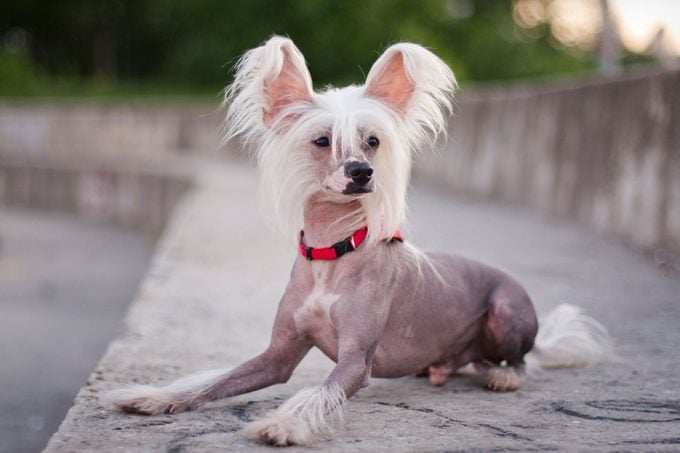
The My Little Pony of dogdom, the crested is the fanciest and most delicate-appearing of the hairless dog breeds, with a prancing gait and flowing mane and tail. Unlike the other hairless breeds, Chinese cresteds have some hair—the hairless version of the breed has long tufts. (The coated variety of the breed—called the powder puff—has long hair all over and is decidedly fluffy.) True, a few of these dogs have won ugliest-dog contests, but the typical crested is more likely to win Miss Universe.
Chinese sailors used them as ratters and traded them at ports around the world. They got their big break in America when celebrity stripper Gypsy Rose Lee fell in love with the scantily clad canines and bred and promoted them in the 1950s and ’60s.
Cresteds are cuddle bug cuties but also smart and clownish. They love to learn tricks and excel at the sport of dog agility, where they look like tiny horses galloping around and jumping the hurdles. They make ideal pint-size partners in adventure.
Cresteds are the smallest of the hairless breeds, standing 11 to 13 inches at the shoulder and weighing 10 to 13 pounds. They’re classified as an AKC toy breed.
Xoloitzcuintli
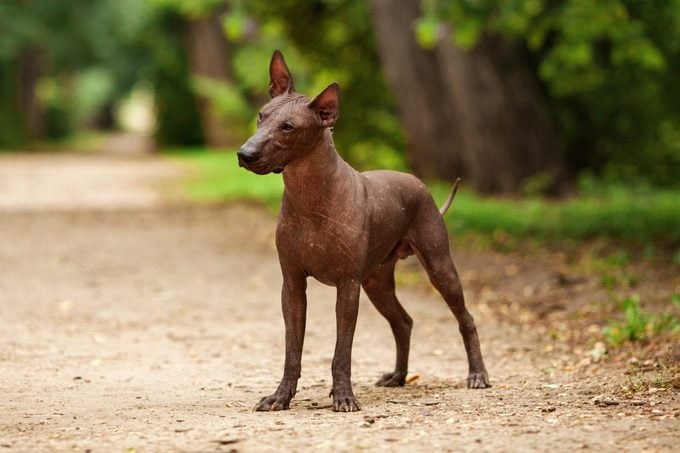
It’s pronounced show-low-eats-QUEENT-lee—or just Xolo for short. This breed was in Mexico at least since the time of the Aztecs. It was considered sacred, and the dogs were even sacrificed when their owners died in order to guide the owner’s soul through the afterlife. Sometimes the dogs were the main course at special feasts. Luckily, both customs are now out of style.
In the late 1800s, the AKC recognized them as the Mexican hairless. But so few were registered over the next 50 or more years that they were feared extinct, and they became the only breed ever dropped from the AKC’s list of recognized dogs. In 1954, an expedition to find any remaining Xolos trudged through the wilds of Mexico and brought back 10 dogs. From there, the breed was revived and eventually re-recognized by the AKC, only now with a name nobody can pronounce!
The Xolo’s role as the mascot of the Club Tijuana Xoloitzcuintles de Calient, a Mexican soccer team, has brought much attention to the breed recently. It’s a tough, loyal dog that looks like a living onyx or marble statue with its gleaming skin and pronounced muscles.
The Xolo is one of the stockier hairless dog breeds and comes in three sizes: toy (10 to 14 inches at the shoulder), miniature (14 to 18 inches) and standard (18 to 23 inches), with a weight range of 10 to 55 pounds. They’re a member of the AKC non-sporting group.
Peruvian Inca Orchid
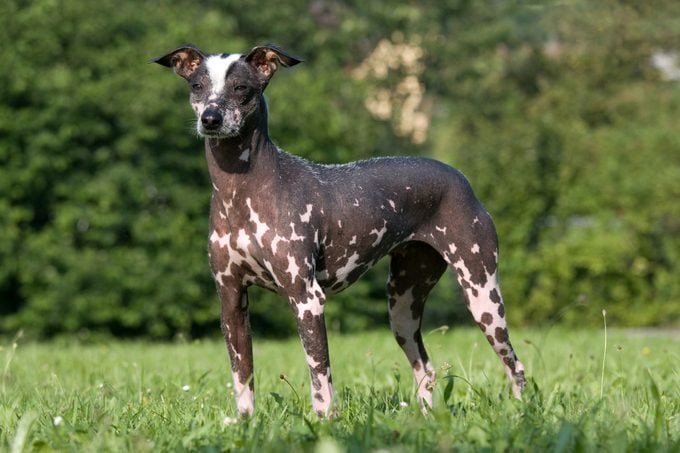
Hailing from the Incan Empire, Peruvian Inca Orchids (PIOs for short) were thought to have healing powers in ancient times, probably because their furless bodies felt so warm—they were like living heating pads. After the conquistadors came, most were lost; they were rediscovered in the Andes in 1966. In 2001, Peru declared the breed a National Patrimony, and it is now protected in that country.
The fleet-footed PIO is slimmer and racier than the Xolo, which is why it’s categorized as a sight hound. Their skin can be solid or mottled, and it’s either brown, gray or copper. This is an independent breed, and these dogs tend to attach to one person.
They come in three sizes: small (10 to 16 inches and 9 to 19 pounds), medium (16 to 20 inches and 18 to 26 pounds) and large (20 to 26 inches and 26 to 55 pounds). They’re currently in the AKC miscellaneous group, but they will probably one day advance to the AKC hound group.
American hairless terrier
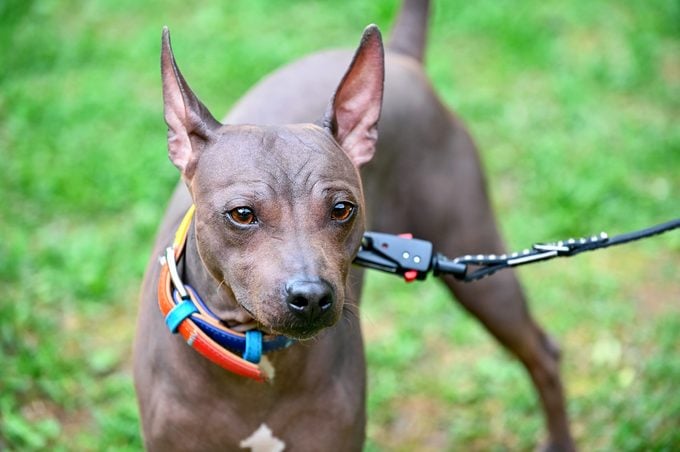
The American hairless terrier had its official start in 1966 with the birth of a fuzzy puppy from coated rat terrier parents. The puppy lost all its hair as it grew up. A few such puppies had been born in the past, but this time, breeders saw its genetic importance because it had normal teeth, unlike other hairless breeds. They carefully bred this dog and its hairless descendants, crossing back to rat terriers to increase the genetic diversity and health of this new breed.
Unlike the other hairless dogs, AHTs have normal teeth and are totally hairless—no tufts at all. Even their skin is different. “The first thing people usually notice is how soft they are compared to other hairless breeds,” says veterinarian and AHT owner Kate Hornick, DVM. “AHTs don’t have the bristly body hair or the rougher, thicker texture to their skin.”
Of course, the real appeal of the AHT is that it’s a terrier through and through, which means it’s tough, feisty, clever and playful. These dogs love to hunt and dig, but they’re also fans of a cuddle.
AHTs are smaller dogs, standing 12 to 16 inches at the shoulder and weighing 7 to 14 pounds. They’re in the AKC terrier group.
Other hairless dog breeds
Other hairless breeds exist—but some are so rare they may be extinct.
Argentine Pila
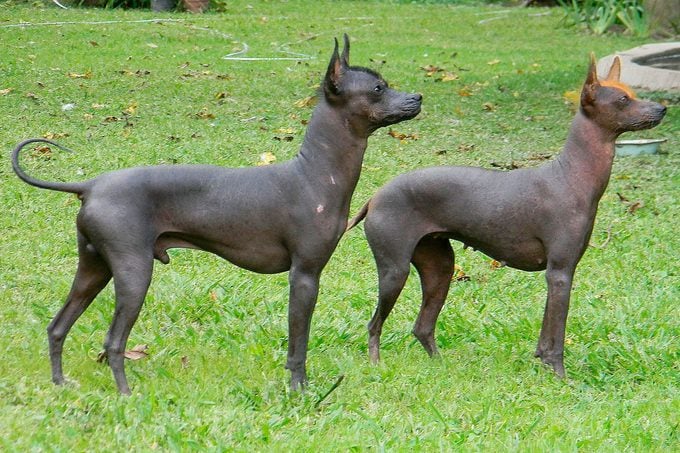
This Argentinian dog can be small (9 to 13 inches at the shoulder), medium (13 to 18 inches) or large (18 to 22 inches). The coated version has short hair. The hairless version has a tuft of short bristly hair on the top of its head. The skin can be black, gray or brown.
Bolivian hairless dog, or hairless Khala
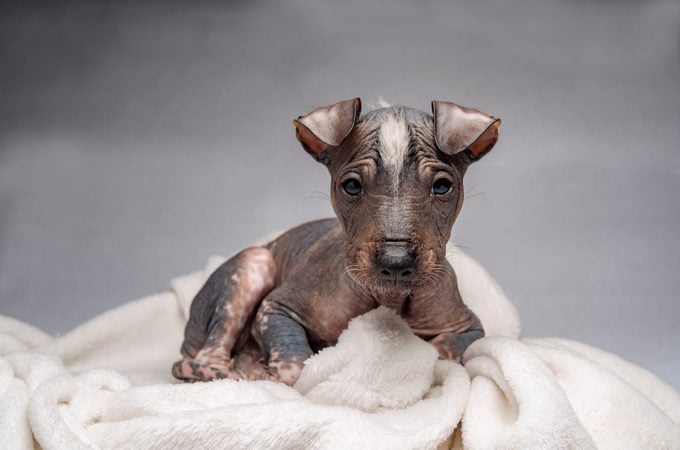
This breed has long hair in its coated version, but the hairless variety has only a tuft of long, flowing hair on its head, giving it a rock star look. It comes in two sizes: medio, which has short legs, stands 14 to 17 inches at the shoulder and weighs 15 to 20 pounds; and grande, which has long legs, stands 17 to 20 inches and weighs 18 to 30 pounds.
Jonangi
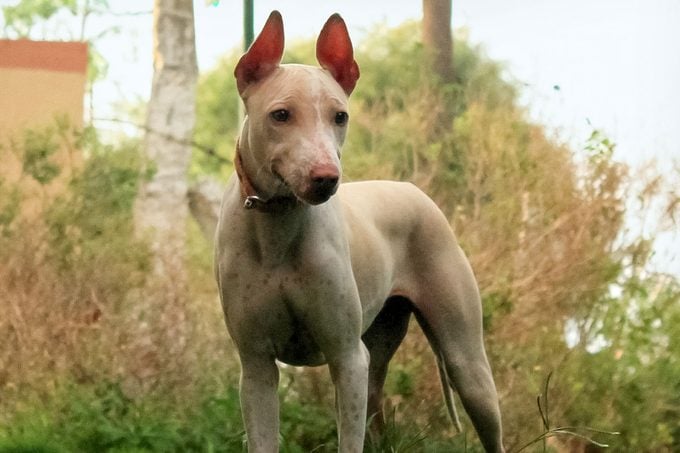
This is the only hairless dog from India. Once used for duck herding, the Jonangi is now almost extinct, though breeders are trying to revive the breed. These dogs stand 18 to 22 inches at the shoulder and weigh 45 to 85 pounds.
Abyssinian sand terrier, or African hairless dog
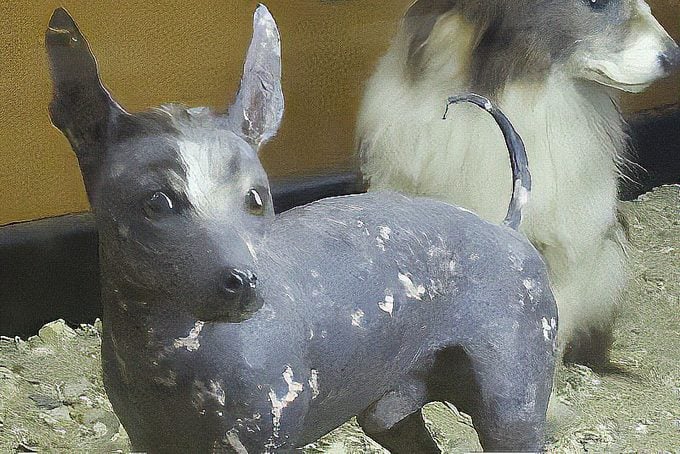
This dog with big ears and patchy dark-and-light skin is so rare that it may already be extinct. The last verified specimen (shown, above) dates back to 1903 and is stuffed in a museum in England!
Ecuadorian hairless dog
This super-rare breed comes from Ecuador’s Santa Elena Peninsula and is probably descended from the PIO or the Xolo, but nobody knows for sure. Just how rare is this dog? No verified photos of the breed exist. Maxing out at a height of 18 inches, it is shorter-legged than other hairless breeds.
FAQs
How do you care for hairless dogs?
Hairless dogs may be the answer for people who hate to brush their pup’s fur. But don’t get too excited; they still need skin care to prevent dry skin, sunburn and even blackheads and acne. It can be tricky.
“Personally, I rotate between a benzoyl peroxide and antibacterial/antifungal shampoo,” says veterinarian and Chinese crested owner Teresa Burks, DVM. “Weekly bathing is a must. Just like people, every dog’s skin is a little bit different. Too much lotion or not the right one for the dog can cause more blackheads. Not enough lotion, and their skin can be dry.”
The skin must be protected from sunburn. “Sun protection, either baby SPF 50 sunblock or sun shirts/clothes are a must,” says Dr. Burks. “If you need it, they do. They tan—and burn—just like we do.”
They also get cold easily, so be prepared to have a stylish wardrobe for them all year long. Of course, this is half the fun! But these are definitely not outdoor dogs.
Are hairless dogs hypoallergenic?
Hairless dogs may be hypoallergenic, but they can still cause allergic reactions—just maybe not as much as furred dogs. It’s not the hair people are allergic to but the dander from the skin. Fortunately, it’s easier to control the dander in hairless dogs, explains American hairless terrier breeder Angie Claussen.
“They produce the same amount of lubricating skin oil as do coated dogs, but instead of being dispersed into the coat, it stays on the skin surface, trapping the normal skin dander, thus keeping the dander out of the environment and making it less problematic for allergic people,” Claussen says. “When the dog is bathed, the dander goes down the drain.”
Why trust us
At Reader’s Digest, we’re committed to producing high-quality content by writers with expertise and experience in their field in consultation with relevant, qualified experts. For this piece, Caroline Coile, PhD, tapped her experience as an award-winning journalist specializing in canine breeds, health and science. We verify all facts and data, back them with credible sourcing and revisit them over time to ensure they remain accurate and up to date. Read more about our team, our contributors and our editorial policies.
Sources:
- Teresa Burks, DVM, veterinarian at Solomon Animal Hospital in Wichita, Kansas; email interview, Feb. 6, 2024
- Angie Claussen, longtime breeder of top-rated American hairless terriers under the Poise kennel name and AKC Breeder of Merit; email interview, Feb. 4, 2024
- Kate Hornick, DVM, veterinarian at Mentor Animal Hospital in Mentor, Ohio; email interview, Feb. 2, 2024
- Archaeological and Anthropological Science: “Special pet, special care. Diet, provenance, and health analyses of a dog reveal strong ties with humans in Patagonia”
- Scientific Reports: “The dental phenotype of hairless dogs with FOXI3 haploinsufficiency”
- Philosophical Transactions B: “The bald and the beautiful: hairlessness in domestic dog breeds”

